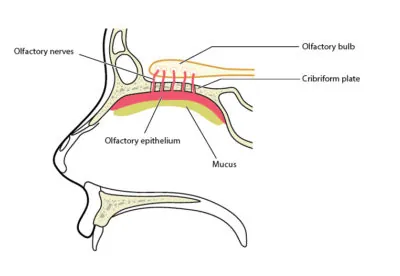The Cribriform Plate and Neurodegenerative Disease
Recent research suggests that diseases like Alzheimer’s could be caused by a drainage problem.
What is the purpose of the cribriform plate?
 The cribriform plate is the part of the ethmoid bone that forms the roof of the nasal cavity. The plate is a narrow structure that contains deep grooves known as olfactory fossa, which support the olfactory bulb. The plate contains a number of holes known as the olfactory foramina, through which pass the olfactory nerves that carry the sense of smell.
The cribriform plate is the part of the ethmoid bone that forms the roof of the nasal cavity. The plate is a narrow structure that contains deep grooves known as olfactory fossa, which support the olfactory bulb. The plate contains a number of holes known as the olfactory foramina, through which pass the olfactory nerves that carry the sense of smell.
The cribriform plate and the spinal regions are thought to be the main cerebrospinal fluid (CSF) outflow routes and how the brain clears out accumulated waste.
The cribriform plate in the context of aging
During the aging process the plate becomes more ossified and less porous and the small holes through which the nerves pass close up and restrict the flow of CSF. The result of this is thought be a reduced ability to “wash” the brain clear of accumulated waste.
Neurodegenerative conditions are associated with the accumulation of waste in the brain, including amyloid-β, α-synuclein, tau, and a few others. This accumulation of this waste is believed to be one of the reasons we age. In the case of Alzheimer’s disease, some research suggests that the onset and progression of the disease may be due to the age-related reduction of CSF drainage from the brain through the cribriform plate. While the cribriform plate is not the only path CSF can take from the brain, it is the one that drains it from the olfactory bulb region, and this is where Alzheimer’s pathology and amyloid-β aggregation may originate.
Working on a possible solution
Leucadia Therapeutics is a company developing a therapy based on improving CSF drainage through the cribriform plate as a potential way of addressing Alzheimer’s disease. Initial studies in ferrets supports this research direction, and when they artificially blocked drainage via the plate, they observed an increased accumulation of waste and cognitive impairment. They chose ferrets because mice are poor models for Alzheimer’s disease and do not develop the disease naturally.
They plan to use an approach similar to adding a shunt, a hole or a small passage that moves, or allows movement of, fluid from one part of the body to another. The idea is similar to how surgeons add stents to arteries to keep the passageway open; in this case, the aim would be to keep the foramina open by using something similar to a stent.


